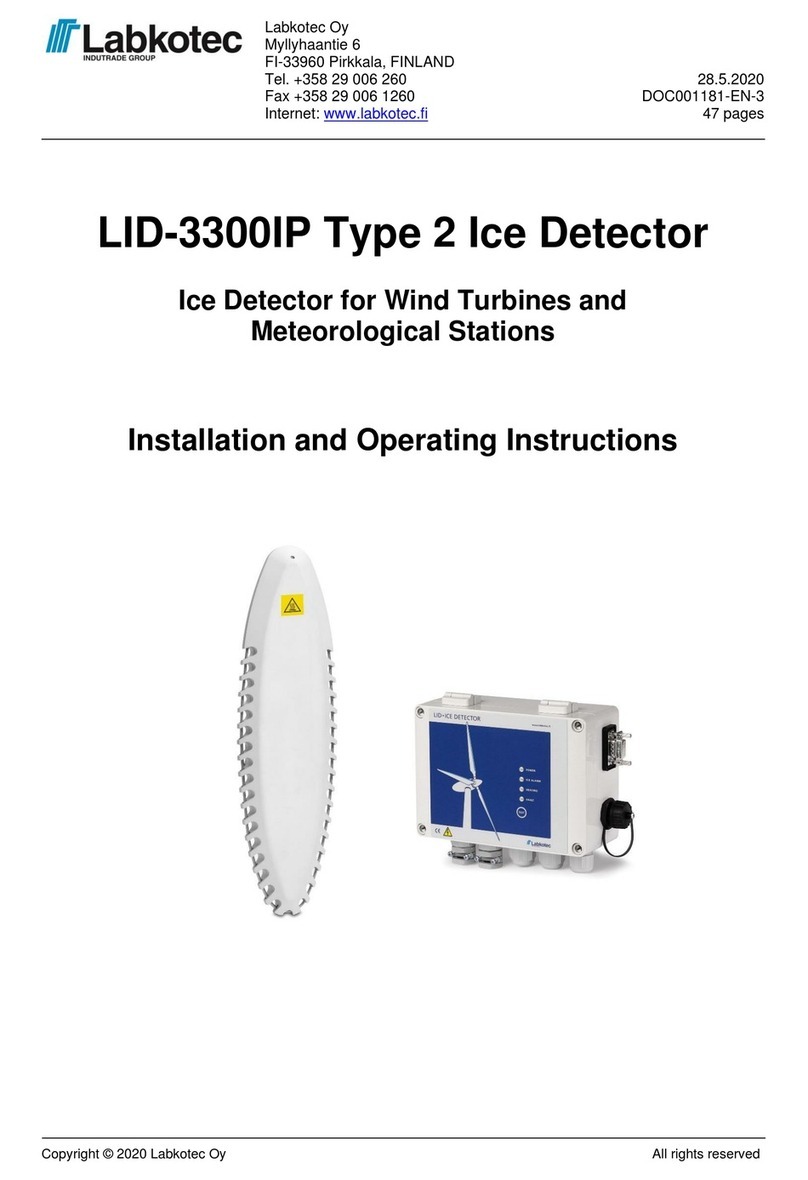LID-3300IP Ice Detector D80186JE-3
Installation and Operating Instructions
Copyright © 2016 Labkotec Oy 9/37
3 LID-3300IP ICE DETECTOR IN OPERATION
This chapter explains the basic operation of LID-3300IP. Serial and
Web user interfaces are explained in different chapters.
3.1 Operating modes
LID-3300IP operates in different modes which are explained below.
SENSING MODE
LID-3300IP continuously measures the signal level of the ice sensor.
The maximum signal amplitude value can be defined by the user by
parameter 2. By default, the signal value varies between 0 and 100.
Ice signal value is visible in serial and web user interfaces, and
available as continuous current message in the analog output.
ICE DETECTED MODE
When ice signal goes below a defined alarm level (set by parameter 0),
LID goes to Ice detected –mode and gives an ice alarm. The delay of
an ice alarm can be set by parameter 3.
Ice alarm is visible in the Ice alarm LED of the front panel as well as
serial and web interfaces. Ice relay energizes and closes contacts 8 and
9.
Ice alarm and Ice detected mode are active during the Heating and
Cooling phases that follow an ice alarm.
Parameter 22 can be used to set a delay for ice alarm deactivation. It
will keep the ice alarm active after the heating and cooling phase for the
duration of the time delay. This is to prevent repetitive alarms during a
long icing event.
HEATING PHASE
Right after the ice alarm is detected, sensor starts to heat itself to get
rid of the accumulated ice. It is also possible to disable heating by
parameter 12. The whole heating process can be controlled with
parameters 12 –18, 23 and 24. Default heating parameters shoud be
useful enough for most weather conditions.
Automatic heating is used to remove soft ice which has slowly
accumulated over the sensor in light icing conditions. It does not
generate an ice alarm. Automatic heating is controlled with parameters
23 and 24.
COOLING PHASE
When sensor is heated to the maximum heating temperature, LID
moves to Cooling phase. Ice signal value is measured all the time and
it should be close to the maximum after the Heating phase.
Cooling phase has ended when sensor temperature is close to ambient
temperature (parameter 20), or maximum cooling time (parameter 19)
has exceeded, or sensor temperature has gone below 0 ºC.
Ice alarm is released after the cooling period if ice signal value is above
the alarm level.
FAULT MODE
LID indicates a fault or failure if there are problems in icemeasurement,
temperature measurements, heating or in other operations of the unit.
Fault indication is visible in the Fault LED in the front panel, serial and
web user interfaces and in the fault relay output.
Please note that the Fault relay is normally energized, providing thus a




























